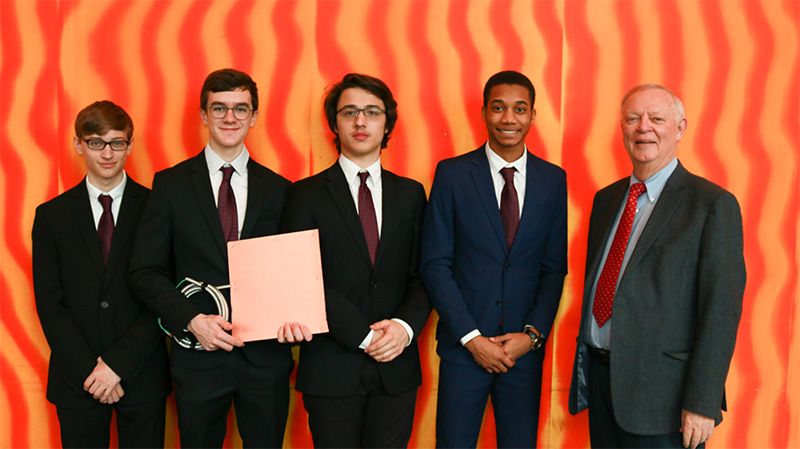Rising to the Final Round of the Innovation Challenge

An app whose student creators say is the solution to the small business tech gap in their local shopping district and a device that functions as an early alarm system for uncovering atherosclerosis took the first-place slots in the Illinois Tech Innovation Challenge in a final round pitch event held on January 25 on Illinois Institute of Technology’s Mies Campus.
Five teams from two categories—Illinois Tech students and Chicago-area high school students—advanced to the final round of the competition with the top three teams earning monetary prizes. Entrants submitted their ideas last fall to the School of Applied Technology, which hosted the event. Besides pitching their idea before a faculty panel, each of the five teams submitted a summary video. The first-place teams received $2,500, the second-place teams $1,000, and the third-place teams $500. Additionally, each of the team members of the top three high school teams also received a $25,000 per year scholarship for up to four years. The Fogelson Family Foundation and The Coleman Foundation were the major sponsors of the Illinois Tech Innovation Challenge.
Top Three Projects from Illinois Tech Students
First Place—Mercial
Problem: Businesses in the Little Village neighborhood of Chicago lose opportunities because they are reluctant to implement modern technology. Many don’t even take advantage of offering low-tech money-saving coupons to customers.
Solution: The Mercial app platform comprises a system in which businesses scan offers and coupons they upload with another device provided by the Mercial team, which can also lead to online sales. The team also proposes the use of an in-app currency, Merchips, to help consumers redeem better savings offers.
Second Place—POE Safety Alert System
Problem: With the exception of fire and tornado alarms, most campuswide current emergency systems consist of nondescript alarms with no indication to students of the issue that raised the alarm or next steps for a particular situation.
Solution: With its RGB-LED light integration and potentially standard light switch integration, the POE Safety Alert System can define which alarm is activated and where the emergency is occurring, and then offer a more tailored management approach for each situation.
Third Place—Brown Bear
Problem: The federal government is currently seeking smart technology that can identify possible threats and verbalize threats in real time. This technology needs to be portable and durable across multiple terrains and intelligence collection operations conducted by military forces.
Solution: Brown Bear is a device that could be carried and thrown by military operators on patrols. It would have a 360-degree view through cameras that would detect figures to a relative percentage and then verbalize what is seen through an earpiece. Brown Bear would provide nonvisual information to keep military forces moving without the need to look at a bright screen.
Top Three Projects from High School Students
First Place—Blood Mobility and Artery Elasticity Analyzer
Hinsdale Central High School
Problem: Atherosclerosis, an inflammatory disease of the arteries that largely contributes to cardiovascular issues, is commonly detected through MRI and CT scans, but such methods are expensive, often restricted to hospital patients, and typically prescribed after a problem is suspected.
Solution: The Blood Mobility and Artery Elasticity Analyzer would determine arterial blood mobility and arterial elasticity in the front arm and fingers, thus functioning as an early alarm system to potential atherosclerosis. It would create a way for people to track the elasticity of their arteries and mobility of their blood giving them a way to diagnose themselves with potential atherosclerosis. The device would give many the ability to monitor their health easily and notify them of any potential arterial issues that they would need to address before a major health event occurs.
Second Place—The Charge Card
Wheaton North High School
Problem: Current portable phone charging systems are big and bulky preventing many users from carrying them on a daily basis.
Solution: The Charge Card is a slim, portable, wireless charger for everyone who uses their phone throughout the day. Its 2,700 milliampere-hour battery can rapidly charge a phone back to 100 percent for a seamless charging experience.
Third Place—Presistant
Holy Trinity High School
Problem: Some 70 percent of employed Americans agree that presentation skills are crucial to success at work, yet an estimated three-quarters of the population experiences pre-speech anxiety. Additionally, University of California, Los Angeles researchers have found that much of a presentation’s message actually arises out of nonverbal language, something current presentation-improvement software does not address.
Solution: The Presistant app acts as a smart presentation assistant to solve these problems and enables users to improve presentation skills. It would accelerate the learning of both visual and vocal presentation skills through motion tracking, artificial analysis vocal analysis, and artificial analysis silhouette analysis. Once the user downloads the app and describes their presentation, they are ready to begin their first practice session. After recording themselves, Presistant does the rest.




